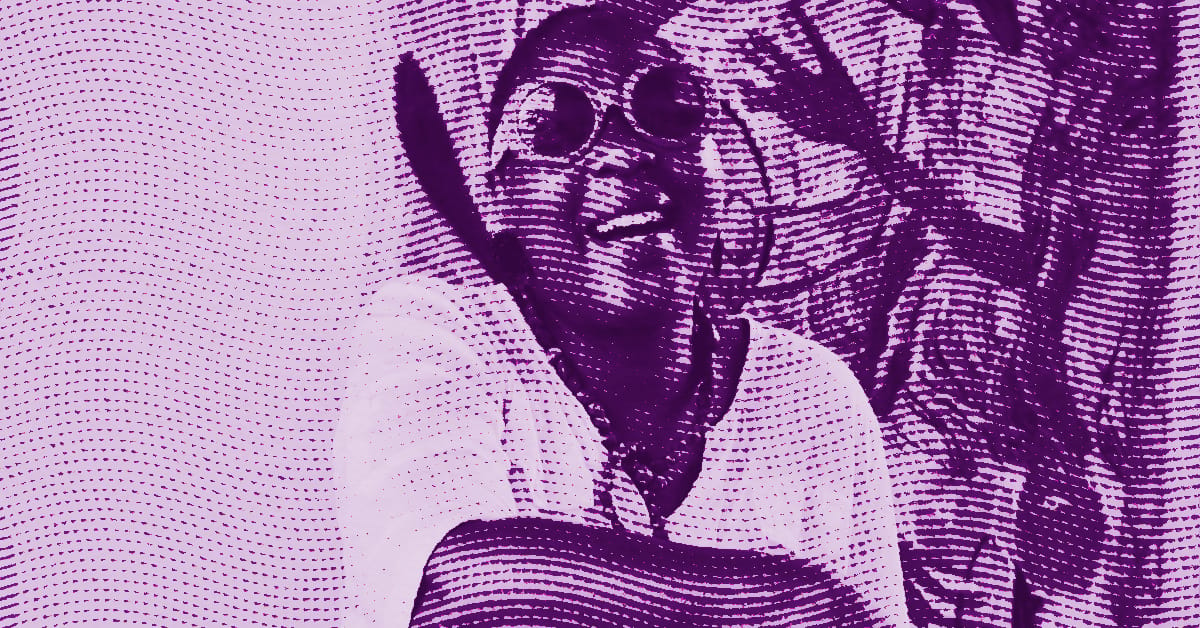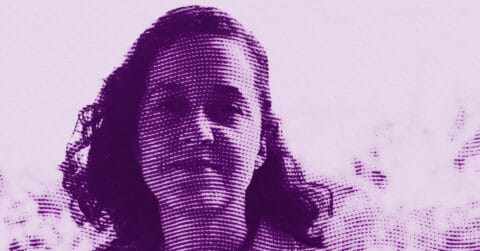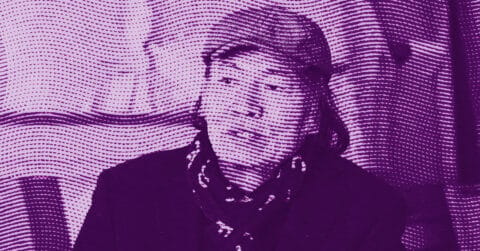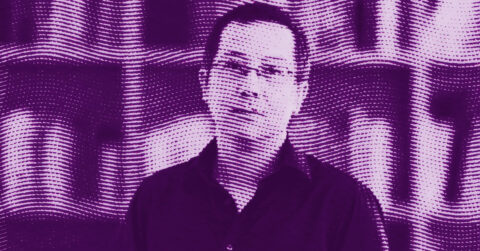Listen to me carefully, you bunch of snobs: you who haunt openings while sipping bad champagne, you who collect signifiers without ever confronting the signified, prepare to meet an artist who refuses your comfortable categories. Pélagie Gbaguidi, born in Dakar in 1965 and living in Brussels, couldn’t care less about your greasy compliments on the aesthetics of her works. This Beninese woman trained at the Saint-Luc School of Fine Arts in Liège in 1995 defines herself as a contemporary griot, a term that should make you reflect on your own position as a Western spectator, comfortably settled in collective amnesia.
Her work is not decorative; it is visceral. Her paintings, drawings, and installations do not seek to please but to tear apart the veil of forgetting that we have draped over the founding violences of our modernity. When she exhibited at Documenta 14 in 2017 her monumental installation The Missing Link: Dicolonisation Education by Mrs Smiling Stone, she did not just occupy the space; she haunted it. School desks, rolls of paper suspended from the ceiling, archival photographs, earth and lipstick on paper: these are the materials with which Gbaguidi constructs her memorial epics. This installation directly questions the transmission of knowledge about slavery, Nazism, and apartheid, raising the disturbing question: who decides what deserves to be taught, what must be remembered, and what can be forgotten?
The link between Gbaguidi and decolonial thought, particularly that developed by the Martinican philosopher Malcom Ferdinand, is not accidental but structural. In his work Une écologie décoloniale published in 2019, Ferdinand theorizes what he calls the “double fracture” of modernity: on one side, the environmental fracture carried by a technocratic and capitalist civilization; on the other, the colonial fracture established by Western colonization and imperialism [1]. Gbaguidi artistically embodies this double fracture that Ferdinand conceptualizes philosophically. When she states in an interview: “I have developed a related research line by considering nature as a physical and organic archive” [2], she exactly aligns with Ferdinand’s concern that the ecological crisis cannot be separated from colonial history.
The artist goes further by stating: “the discovery of the prehistoric sites of Sterkfontein deeply inspired me, and resonates even more strongly today within the framework of decolonial ecology, referring to the work of Malcom Ferdinand, and how nature bears witness to all these tragedies and crises that we are experiencing” [2]. This intellectual convergence between Gbaguidi and Ferdinand reveals a shared understanding: anti-racist, feminist, and rights and freedoms struggles must find common ground, as they all stem from the violence of the colonial legacy and imperialism as current markers of global economic, identity, and ecological crises. Gbaguidi does not merely illustrate these ideas; she embodies them in an artistic practice that makes her very body a place of resistance and repair.
In her project Hunger, created with a collective of artists called On-trade-Off at Z33 Hasselt, Gbaguidi raises the issue of hunger in the world by posing this fundamental question: why do we not talk about the causes of poverty? This question directly echoes Ferdinand’s thought, who, in his conception of decolonial ecology, emphasizes the necessity of revealing the causes of poverty rather than accepting it as a fact. For Gbaguidi as for Ferdinand, it is about producing knowledge that contributes to eliminating coloniality and improving living conditions on the planet. The artist rejects the compartmentalization of struggles and shows that the predation of natural resources, violence against racialized bodies, and ecological destruction are intrinsically linked.
Gbaguidi’s artworks materialize what Ferdinand calls the “colonial habitation” of the earth, this particular way of inhabiting the world which denies the other, human or non-human, the right to be co-inhabitant of the planet. Her drawings and paintings, with their perforations and holes piercing the surface of the paper or canvas, can be interpreted as openings onto another reality, but for the artist, they are above all a gesture of care. These perforations are not wounds but acts of breathing, attempts to let air circulate in suffocated histories. Gbaguidi perforates the official archive, the one that was constructed to justify domination, to let the voices of the dominated emerge.
Defining herself as a contemporary griot, the artist redefines the dimension of orality in traditional heritage through her own approach to plasticity. She does not only transmit stories; she reactivates them through the artistic gesture. Her colored pencil, wax, and oil pastel drawings become rituals of repair, celebrations that escape trauma. As she explains: “The toxic material, linked to the colonial archive, is processed by rhymes which are sung through poetry, painted, drawn, and ritualized by performative gestures. Each drawing is a celebration that escapes trauma, a small victory over the psychological horror of our time” [2].
If Gbaguidi dialogues with contemporary decolonial philosophy, she simultaneously roots herself in a direct and uncompromising confrontation with colonial history. Her work on the Code Noir, initiated in 2004, constitutes one of the most striking examples of this critical archaeology. The Code Noir, a French royal edict promulgated in 1685 by Louis XIV, codified slavery in the French colonies and legally defined the status of enslaved persons as “movable property.” This legal text, which regulated the life, death, punishments, and reproduction of slaves, is one of the most obscene monuments of Western history. Gbaguidi does not evoke this document with the academic distance of historians; she traverses it, tears it apart, rewrites it.
Her series Le Code Noir, presented notably at the Dakar Biennale in 2006, consists of seven canvases that extract the violence of this legislative text and make it visible in all its horror. The artist does not reproduce the Code Noir; she brings out the visible and invisible traumas, the collective neuroses it generated and that persist across generations. This memorial work led to the acquisition of one hundred drawings by the Mémorial ACTe in Guadeloupe, recognizing the artistic and educational value of this work [3]. Gbaguidi transforms the colonial archive into an educational tool to understand the mechanisms of enslavement and the fabrication of racial ideologies.
Gbaguidi’s approach to colonial archives is radically different from the traditional museological attitude. She does not limit herself to passively consulting historical documents; she confronts them, questions them, puts them into crisis. In her work Naked Writings, for which she investigated the archives of the Royal Museum for Central Africa in Tervuren, the artist performs what she calls a “de-fossilization of the gaze.” The title refers to the importance of unlearning, of shedding prior beliefs, and, consequently, of decolonizing the mind. For her, the archives are not inert objects of the past but always active weapons that continue to structure our present.
When Gbaguidi creates her series De-Fossilization of the Look in 2018, in dialogue with Piero della Francesca’s Madonna del Parto (after 1457), she is not simply engaging in comparative art history. She scrutinizes this Renaissance imagery through a series of automatic drawings and paintings, questioning the representation of sanctified motherhood and the place and agency of women in patriarchal society. This pregnant Madonna, whose dress is undone, exposing an undergarment, whose face and posture express fatigue, becomes for Gbaguidi an entry point to question official narratives about femininity, motherhood, and the body.
The artist subverts the Renaissance tradition of linear perspective with a fisheye objective: she captures everything simultaneously, envelops her subjects, and dissects them into fibers, as if looking at them from within. As she states: “I draw without perspective: my perspective is a perspective of a child, a bird, an insect, and a fish” [3]. This statement is not trivial. By rejecting linear perspective, this technical conquest of the Western Renaissance which imposes a single, central, sovereign point of view, Gbaguidi also rejects the colonial epistemology that claims there is only one legitimate way to see and know the world.
Her installation for the Lubumbashi Biennale in 2019, Echo museum, the archive and Udji Kinge, described as “a video about performances in ore quarries, intended to reveal psychological spaces affected by social and political issues,” embodies this working method. Gbaguidi films bodies at work in the mines of the Democratic Republic of Congo, these bodies exploited to extract the minerals necessary for our “green” technologies. She reports: “In the mines of the Democratic Republic of Congo, women, children, and men illegally extract minerals, working with bare hands, without protection from the sun, to crush big stones into gravel. They fill buckets that they sell to survive. Three hours of work to fill a bucket cost 20 cents” [2].
This contemporary economic violence is not, for Gbaguidi, an accident of globalized capitalism but the direct continuation of colonial extractivism. History is not dead; it continues in new forms. The artist rejects the techno-solutionist discourse that would claim our “eco-responsible” actions can be disconnected from these harsh realities. On the contrary, she insists that our behaviors, wherever we live on this planet, are linked to create an economy of relationship, a moral ethic of mental well-being.
During the Covid-19 pandemic, Gbaguidi developed a particular reflection on the intersections between contamination, confinement, and segregation policies. She recounts having been reminded of Jacques Derrida’s inquiries into sovereignty, but specifies: “I was not in quest of sovereignty; I was rather asking for a dialogue with nature, asking for care, asking for the healing of mother earth” [2]. This nuance is crucial. Gbaguidi does not seek to assert individual or collective sovereignty that would replicate patterns of domination, but to establish a caring relationship with the living. The lines of her drawings brought her back to the essential and reactivated the sense of the collective. They allowed her to make more space for the invisible and lay it bare, reborn through the elementary gestures of daily life and conversation.
This attention to care runs throughout her recent practice. The perforations in her drawings and paintings, which she explicitly describes as “an act of care,” function as breaths within suffocating narratives. Her work Chaine Humaine (2022), a series of drawings made with oil pastel, wool, and colored pencil on paper, shows intertwined, connected bodies forming chains that evoke both the chaining of slavery and the solidarity of resistance. These bodies are not individualized but collective, reminding that liberation can only be a common endeavor.
In her exhibition Le jour se lève at the Zeno X Gallery in 2022, Gbaguidi raises questions that resonate directly with contemporary political urgency: How can we exist without dominating others? Why does society need human capital? What is the relationship between object and subject in the capitalist world? These questions are not rhetorical but materialized in the exhibited works, which articulate the pain and continuous and latent violence linked to collective neuroses. The paintings Le jour se lève: Ritual & Green and Le jour se lève: The Mutants (2021), made with acrylic and pigment on canvas, show human figures in mutation, caught in a process of transformation that could be both a dehumanization and a radical reinvention of the body.
Gbaguidi cherishes her connection to animist and matriarchal perceptions of the world, intrinsic to the pre-colonial culture of Benin. She conveys a spirit animated by inherited ancestral and contemporary impressions. This transmission is not nostalgic but resolutely forward-looking. The artist does not seek to resurrect an idealized past but to draw from the epistemologies and cosmologies that colonization attempted to erase, in order to construct other ways of inhabiting the present and envisioning the future. Her artistic practice is in this sense deeply political: she proposes a radical redistribution of the sensible, to borrow an expression that we could take from other thinkers, a questioning of what can be seen, said, thought, or imagined.
The power of Gbaguidi’s work lies in her ability to hold together multiple temporalities: the colonial past that does not pass, the present marked by the persistence of structures of domination, and a future that must be built differently. Her hanging paper scrolls, her drawings unfolding over meters in length, materialize this extended temporality. The work is never closed; it unfolds, continues, and insists. The repetitive gestures of drawing, line after line, figure after figure, become a form of resistance to oblivion, a stubborn insistence on making what has been denied exist.
So, you who have come this far, what should you retain? That Pélagie Gbaguidi is not an artist that one can quietly integrate into your collections without being transformed. Her work demands a responsibility from you: that of recognizing your own position in the systems of domination that she reveals. You cannot simply “aesthetically” appreciate these works without confronting what they say about our world. The beauty she creates is not consoling but destabilizing. It does not soothe your contemporary anxieties but intensifies them, makes them productive. For this is the magnificent paradox of this artist: by confronting us with the worst horrors of our collective history, she opens the possibility of other ways of being together. Her perforations are breaths, her chains are solidarities, her dead archives become living.
Gbaguidi’s work reminds us that art is not a luxury but a vital necessity. In a world where official discourses constantly seek to minimize, to euphemize, to forget structural violences, the artist keeps the wound of memory open. Not out of masochism, but because only a living memory can allow authentic healing. As she expresses it with sharp lucidity: “My work revolves around the idea of seeing speech and images as signs that must be deciphered and transmitted” [2]. Deciphering and transmitting: this is the double movement that drives her practice. Deciphering the signs that coloniality has inscribed in our bodies, our territories, our imaginaries. Transmitting not a definitive truth but a method of inquiry, a way to remain vigilant, not to be lulled by conventional narratives.
In the face of the collective amnesia that our societies cultivate with such care, Gbaguidi opposes an active, critical, performative memory. Her work is not that of a historian who documents the past but that of a griot who summons the dead so that they haunt the present and compel us to answer for our actions. In this uncompromising confrontation with historical horror, there is paradoxically a form of hope, not the naive hope that everything will get better, but the stubborn hope that another way of inhabiting the world remains possible if we accept to face where we come from. Pélagie Gbaguidi’s work does not offer us easy consolation, but it gives us something more precious: the possibility to think and act differently, to build what she calls, with others, an “economy of relation,” a world where ecological and decolonial struggles are no longer separate but understand that they confront the same adversary. It is this relentless lucidity, served by an artistic practice of rare intensity, that makes Gbaguidi an essential figure of contemporary art. Not because she flatters us, but because she forces us to grow.
- Malcom Ferdinand, An Ecological Decoloniality. Thinking Ecology from the Caribbean World, Paris, Le Seuil, 2019
- Jareh Das, “The Body as Archive”, interview with Pélagie Gbaguidi, Ocula Magazine, 18th Istanbul Biennial, 2023
- “Pélagie Gbaguidi”, Archives of Women Artists, Research and Exhibitions, 2024
















